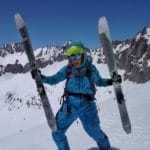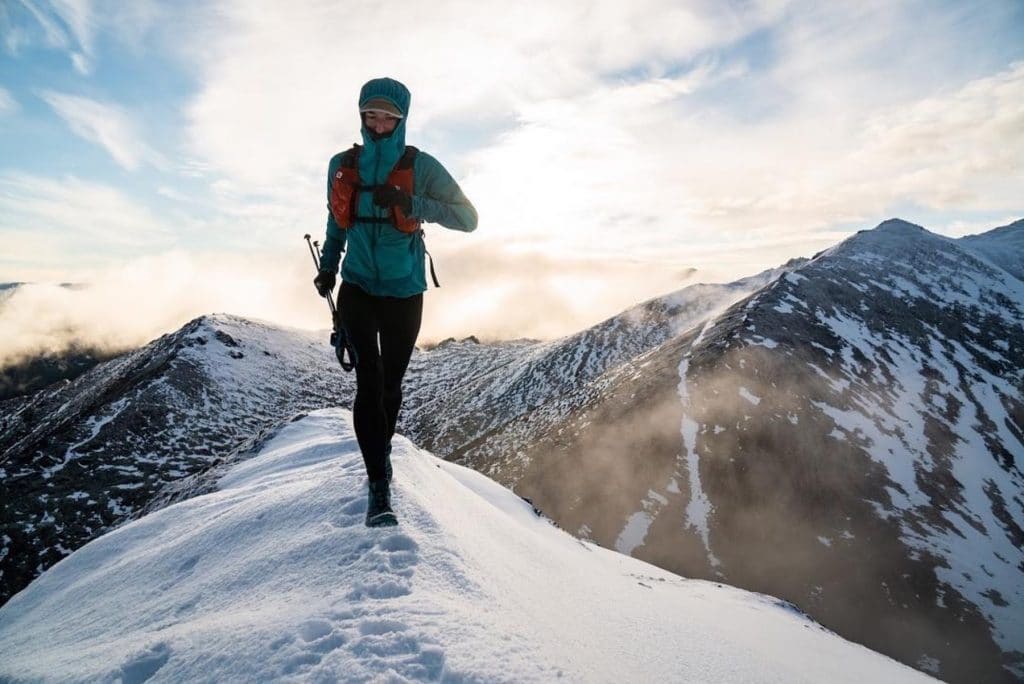Trail Running (Ski Touring) Snow Safety – Considerations

Share This Article!


Weather, snowpack structure, terrain, season (fall vs. winter vs. spring) or more specifically date (sun angle), and time of day are factors in determining safety during the “snowy” season. Knowledge of these factors will help with reading avalanche terrain and conditions to increase safety in backcountry travel, whether it be on skis or on foot.

I will briefly touch upon the categories mentioned above to raise awareness of what it takes knowledge-wise to travel in avalanche terrain during the snowy months we are all itching to get out and play in, safely! This is NOT meant to be a comprehensive and exhaustive guide to snow safety. It is an introductory guide to raise awareness of fundamental considerations I personally assess before heading out into the backcountry for a ski tour or mountain trot.
For more in depth knowledge, I HIGHLY recommend taking an American Institute for Avalanche Research and Education (AIARE) Level 1 course! AIARE L1 is a highly developed course generally recognized as the national standard for avalanche education. It will elaborate on everything I discuss in this short blurb. I will also make more recommendations at the end of the article to further enhance one’s knowledge in snow science!
Weather
- Why is it important? (It determines avalanche hazard!)
- How often do I need to check weather? (Following it regularly is necessary to understand avalanche hazard!)
- What are good sources of weather information? (Blogs, forecast discussions and avalanche forecasts for your local area- not basic forecasts!)
Regularly following the weather is so important for understanding avalanche potential! The reason it’s important is because weather (as well as terrain) is what primarily determines avalanche hazard. The importance of this becomes much more clear when one regularly follows weather and reads avalanche hazard forecasts for a year or two. You will begin to see how avalanche hazard rapidly rises during a storm the deposits over a foot of snow and begins tapering over the next 48 – 72 hours after snowfall ends. You’ll see how prolonged wind after a storm can keep the hazard high in areas where wind is transporting snow to, and you might begin to realize the areas getting snow removed by the wind are becoming less hazardous. You’ll begin to learn area-specific avalanche problems like how prolonged cold and dry spells in Colorado can create very dangerous persistent avalanche hazards, or how heavy rains in Washington might reduce persistent hazards but create rain crust layers that avalanches can slide on.
Having a good understanding of avalanche hazard is not something any single article, book or even an AIARE course can give you. A good understanding absolutely requires regularly following the weather (and the avalanche forecast)! Every year brings different weather, and different weather brings different avalanche conditions. An interesting thing to also note is that unique or unusual weather will also create unique, unusual, and potentially unfamiliar avalanche hazard. The more often and more years you follow weather, the more you’ll understand avalanche hazard.
An addition perk of regularly following the weather is developing the ability to anticipate snow coverage and surface texture (icy? soft? dry, wind-hammered hard snow?).
An industry-standard protocol to keep in mind as you learn, is that uncertainty should raise additional caution and conservativeness. If you’re not sure you understand how recent and prior weather has affected avalanche hazard, opt to make more conservative terrain choices like avoiding avalanche terrain.
OpenSnow blogs, NOAA forecast discussions (Google noaa point forecast, type in mountain or specific location of choice, ie: Mount Goddard) and the local avalanche forecast are the main weather sources I personally use. OpenSnow is a weather blog that utilizes a few weather models to derive a forecast from. This blog generates weather information surrounding most mountainous areas with a ski resort, since that’s the primary draw, however backcountry travelers can utilize the information for surrounding mountains in the area. NOAA is the other source I utilize most often for my weather information via the ‘Forecast Discussion’(see images below). The forecast discussion delivers a more comprehensive look at the weather and gives a detailed word description of what is going on with the weather pattern, versus the ‘detailed weather forecast’ which doesn’t give much information other than the basics. The website, Avalanche.org, will allow you to find your local avalanche forecasting center. I highly recommend using all three sources of weather to make better decisions with regards to backcountry travel in the snowy months.




Terrain/Snowpack Structure
- What terrain is safe?
- How do I assess terrain before I go?
- How do I know if the snowpack is safe?
Safe terrain is quite simple, stick to ridge lines or wind scoured areas. However, if you are ski touring this formula is quickly complicated since we tend to gravitate towards avalanche terrain, since the skiing is quite alluring! Sometimes with running and ski touring we may not have the option to ‘avoid’ avalanche terrain and must either cross an avalanche slope or drain in order to approach the line we are skiing. Certain slopes and drains have surrounding terrain at prime angles for slides. Sometimes we cannot mitigate all the risk and must learn to assess conditions, the snowpack, weather and wind banners while we are out on our tour (via foot or on skis). Of course, the goal is to always prepare beforehand via weather sources, caltopo slope angle-shading and your desired route and backup plan in case conditions are not what they appeared to be on paper (which is often the case in the backcountry!).
For instance, having options of different aspects is a great example. Sometimes the temperature or cloud coverage is not what the weather called for and we must improvise. Or we see wind banners (which indicates wind direction, which could be altered by orographics) indicating loading on the slope we intend to ski or run under. In that case, options are great to have because one would want to AVOID being under wind loading areas (areas wind banners are blowing), or solar slopes that are refreezing if clouds suddenly appear.
As I briefly mentioned above, caltopo.com is a great source for looking at the terrain you plan to explore. I like to click on the layers on the far right of the screen and choose the ‘Slope Angle Shading – Fixed’. This is a personal preference, however I find it to be more user friendly for looking at avalanche terrain. Truly, anything with color can slide, even the 27-29 degree slopes, under the right conditions! Utilizing this tool allows you to better assess the surrounding terrain above and around you. I use this in addition to actually traveling in the backcountry quite regularly in all seasons to get a better understanding of what slopes load, get scoured, cross load etc. Traveling in all seasons allows you to see what residual snow remains late fall (ie: ice) and could pose dangers for early season snowfall on a poor surface bed of ice. All of these things are learned throughout many years of backcountry travel in all seasons and definitely not something you should expect to learn within a year of travel, that’s just silliness!
To truly learn how to assess the snowpack, I will again mention AIARE L1 as a start. The course will teach you basic field tests, how to dig pits and most importantly how to assess the pit and the tests that you conduct on the pit you just dug. I mean, we can all dig holes in snow, right 😉 A basic pit test is the compression test. This will test the stability of the snowpack and illustrate the likelihood of a slide happening based on the findings. For instance, if you’re doing a compression test and the test fails at C3, that means the slope is highly reactive since it failed the 3rd time you tapped the back of the shovel on the column. Again, to fully understand this content, I highly recommend a basic snow travel/safety course or AIARE L1 course that will teach one how to dig a pit and perform basic tests; or even partner up with a mentor that would be willing to take you out and show you how to dig a pit/perform basic tests, perform moving assessments (so crucial IMO) and listen to how they observe the terrain and move in avalanche terrain – by far the most useful learning you’ll receive. The quick and dirty test I just mentioned is one I like to use while skinning alone, I use the top of my pole (grip) to plunge into the snow many, many, many times along the way to feel for layers. I am feeling for any hard layer that stops my pole or adds resistance. Firm, hard layers are something that should raise concern for backcountry travelers.


Avalanches
- How do I avoid them?
- How can I mitigate my risk?
- How do seasons change the snowpack?
To avoid avalanches, STAY OUT OF AVALANCHE TERRAIN! Eventually, with enough exposure you will experience kicking off slough or seeing old debris or witness a slide from afar.
To mitigate risk, you must become aware. Knowledge is power. Taking a snow safety course, AIARE L1 Rec, reading ‘Staying Alive in Avalanche Terrain’ by Bruce Tremper are all excellent sources for knowledge on snow science and avalanche safety. Mentorship is another avenue that is highly beneficial to speeding up the learning curve in your mountain range/snowpack.
Snowpacks vary in different ranges, for instance Colorado (Continental) vs Sierra Nevada (Maritime). However, it’s not exactly that easy to classify snowpacks like that since aspects, time of year, depth of the snowpack, what the storm cycle pattern has looked like can make a maritime snowpack quite continental and scary!
Seasons also change the snowpack, for instance, winter vs. spring and the type of avalanches you must be aware of. In winter the avalanche concerns are primarily storm slabs and wind slabs. Thus, you must let the snowpack settle after a storm to allow the storm slab to shed, which usually happens during the storm, or right after. Wind slabs occur with winds that bring storms in and push them out, which pose lingering issues after the storm leaves, hence keeping a keen eye on wind banners for wind loaded slopes. In the springtime, the main avalanche concern are wet slabs, thus heat and sun is needed to fuel this slide, for the most part. Which means timing and aspect is crucial. One must be off of south and east facing slopes early before the sun warms the slope and snow starts to slide. Of course storms occur in the spring and new snow also poses risk, but again, I am attempting to keep this as basic as possible.
Taking an AIARE L1 course or, at a minimum, the free courses at KBYG.org (‘know before you go’) are good starting points for learning about avalanches and safety for snow running in the mountains. Bonus points can be earned from reading a book such as Bruce Tremper’s ‘Staying Alive in Avalanche Terrain’ (in addition to taking an AIARE L1). Next, following weather blogs/discussions and avalanche forecasts regularly throughout the snowy season. Finally, experience. Equipped with knowledge from your coursework or study and having studied weather and avalanche forecasts, get out there to observe and apply your new knowledge! Remember to be conservative as you learn!
About the Author

Share This Article!












